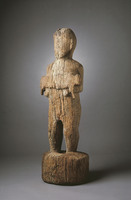 | Back to e-WV
| Back to e-WV
 The West Virginia Encyclopedia
The West Virginia Encyclopedia
 | Back to e-WV
| Back to e-WV
 The West Virginia Encyclopedia
The West Virginia Encyclopedia

The Kanawha Madonna is a mystery from West Virginia’s prehistoric past. This rough wooden statue of a person cradling a small four-legged animal across its chest is housed in the West Virginia State Museum.
The statue, carved from a single tree trunk, stands nearly four feet high. The base is eight inches high with an outside diameter of about 13 inches and a hole, as if for mounting a pole, of about four inches in diameter in its center. The features and hands of the person have weathered away, but there apparently was once a human face. The left ear is intact. The animal is 14 inches long.
The statue was discovered by four teenage boys in an almost inaccessible cave in a cliff overlooking the Kanawha River near Chelyan. It was lying on its back under a four-inch-thick flat stone. It was later obtained by Dr. John P. Hale, distinguished local citizen and president of the West Virginia Historical and Antiquarian Society. Hale visited the cave and in 1897 presented a paper on the statue and its finding to the society. The origin of the name, Kanawha Madonna, is unknown.
The age of the statue is a matter of some disagreement. A radiocarbon date in 1964 estimated the statue to be around 350 years old. Recent testing dated the wood (though not necessarily the statue) to A.D. 1440 to 1600, and identified the wood as honey locust. A similar figure was found in 1869 in a cave near Pineville, Kentucky, and housed for many years in the Museum of the American Indian in New York. Somewhat similar figures have been unearthed at Etowah, Georgia, in Florida, and in the Spiro mounds of Oklahoma.
Written by Joseph Crosby Jefferds Jr.
Hale, John P. History and Mystery of the Kanawha Valley. Charleston: Butler Printing Co., 1897.
Pepper, George H. A Wooden Image from Kentucky. New York: Museum of the American Indian, 1921.